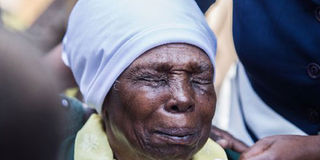Why capture of Dedan Kimathi is still a big puzzle for historians

Mukami Kimathi, the widow of Dedan Kimathi, weeps after receiving her husband's case file from Chief Justice Willy Mutunga at the Supreme Court on March 17, 2016. Mrs Kimathi said there was urgent need to excavate the various points where the hero is suspected to have been interred 59 years ago. PHOTO | ALAMIN MUTUNGA | NATION MEDIA GROUP
What you need to know:
They had never seen eye to eye, from the beginning as Mathenge liked to point out that he had been elected as the leader of all Nyeri battalions while Kimathi was only his clerk.
Kimathi had been elected secretary of the Movement and later on, being a very brilliant organiser, he had risen to the rank of Field Marshall.
The sulking Mathenge never accepted any title and remained a quiet man, busy fighting in the western Aberdares.
The Dedan Kimathi trial papers that were recently handed to his widow have generated a lot of controversy among those who keenly follow the freedom fighter’s life story as to what really happened on
October 21, 1956, after he was sighted by a home guard, at dawn.
Ian Henderson’s book, The Hunt for Kimathi, had been the only source of information on the last desperate days and nights of the freedom fighter.
In the book, the very much feared colonial Special Branch officer describes how the government put together a “pseudo-gang” unit of Mau Mau turn coats who could freely move around in the bush, dressed
exactly like Mau Mau and hunt for their former comrades. It was a brilliant idea that wrecked havoc in the forest, for the tired remaining freedom fighters could not tell the enemy from their own men.
It caused chaos and led to the utter defeat of the Mau Mau, who were already divided after their two leaders — Field Marshal Dedan Kimathi and Stanley Mathenge — had become enemies.
They had never seen eye to eye, from the beginning as Mathenge liked to point out that he had been elected as the leader of all Nyeri battalions while Kimathi was only his clerk.
Kimathi had been elected secretary of the Movement and later on, being a very brilliant organiser, he had risen to the rank of Field Marshall.
The sulking Mathenge never accepted any title and remained a quiet man, busy fighting in the western Aberdares.
The end of Mau Mau really came when Mathenge’s faction tried to negotiate surrender terms with the colonial Government, meeting with the whites in Nairobi and the forest.
During these meetings there was a cease-fire, for the Governor of Kenya, Sir Evelyn Baring, had sent a plane over all the two combat areas, Mount Kenya and Aberdares, scattering down pamphlets which
read: “The Government of Kenya has offered all the fighters to come out of the forest and return to normal peaceful life. His Excellency, the Governor has given a general amnesty to all persons who have
committed crimes during the emergency up to today 18th January 1955. Save your life now! Surrender your fighting weapons and you will not be prosecuted. You will be detained and receive medical
treatment, food, clothing and general care.”
Quite a few had surrendered even before this but had many enemies among the home guards who deeply feared what they might do in revenge if Kenya ever got independent. As
TERRIBLE GAMBLE
General China and Dedan Kimathi had pointed out to the government, many “surrenderees” had been shot on sight by the security forces.
Surrendering was a terrible gamble for even if they got away with their lives, detention camps were no holiday camps and many were tortured to death there.
What we read from Henderson’s book was Kimathi’s desperation, in the final days when he lost his three last comrades, including his forest wife, Wanjiru. Alone and hungry, Kimathi crossed the ditch twice in
two nights to get some maize and bananas. As he was heading back to the forest, a homeguard called Ndirangu Mau shot him in the leg and he was captured.
What the trial papers tell us is that he was heading for a police camp to try and surrender, hoping the homeguards there would spare his life.
This was not to be, for the government had offered Sh10,000 for his head and Sh5,000 for Mathenge’s head. Ndirangu shot Kimathi after he raised his arms and identified himself. Ndirangu and his three
comrades shared the prize, getting Sh3,000 each, a generous amount adding up to Sh12,000.
The Chief Justice of the time, KK O’Connor, sentenced him to hang.
To the Mau Mau, who had taken an oath, surrendering was not an option. Many captured and detained died in torture rather than let out even one secret. Kimathi, himself had told his followers to fight and
never surrender and swore that the British would never even see his bones, as it would be a great shame to his grandmother.




